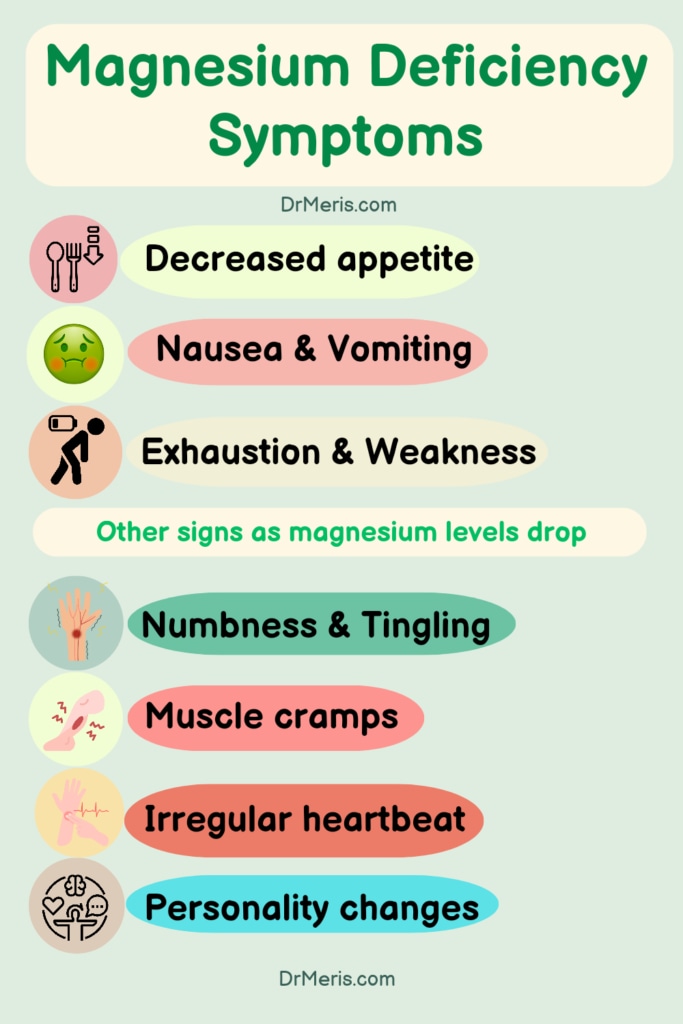Magnesium is one of the seven macrominerals that are necessary for our bodies. More than half of the magnesium is stored in our bones, while the rest is distributed throughout various tissues. Magnesium can be found naturally in a wide range of foods, and it is also available as a dietary supplement. Additionally, it is used as an ingredient in antacids and laxatives.
Low magnesium levels may be associated with a variety of health issues, including type 2 diabetes, heart disease, osteoporosis, and migraines.
Although many entire foods, such as green leafy vegetables, legumes, nuts, and seeds, contain magnesium, up to two-thirds of people in the Western world do not satisfy their magnesium requirements through diet alone.
There are several forms of magnesium, some of which may be a better choice than others for treating certain symptoms and health conditions.
Continue reading to learn everything you should know about magnesium!

Why is magnesium important?
Magnesium is a nutrient necessary to keep your body healthy. It plays a crucial role in supporting over 300 enzymes that carry out important chemical reactions in our bodies.
This mineral is important for many processes in the body. For example, it helps in protein synthesis and the development of strong bones. Magnesium also helps regulate blood sugar levels, blood pressure, and the proper functioning of muscles and nerves. Moreover, it acts as an electrical conductor, allowing muscles to contract and ensuring a steady heartbeat.1, 2
How much magnesium do I need daily?
Your age and gender will determine the quantity of magnesium required. Listed below are the average daily recommended amounts in milligrams (mg).3
- Birth to 6 months: 30 mg
- Infants 7–12 months: 75 mg
- Children 1–3 years: 80 mg
- Children 4–8 years: 130 mg
- Children 9–13 years: 240 mg
- Teen boys 14–18 years: 410 mg
- Teen girls 14–18 years: 360 mg
- Men: 400–420 mg
- Women: 310–320 mg
- Pregnant teens: 400 mg
- Pregnant women: 350–360 mg
- Breastfeeding teens: 360 mg
- Breastfeeding women: 310–320 mg
Health Benefits of Magnesium
As we’ve seen above, magnesium is essential for the proper function of the heart, bones, muscles, nerves, and other bodily parts. These parts malfunction when there is insufficient magnesium.
Results from clinical trials suggesting that magnesium supplementation can treat multiple diseases are conflicting, despite epidemiological studies linking lower disease rates with greater magnesium diets. That could be because, in contrast to supplements that just offer one mineral, a diet high in magnesium is frequently higher in other nutrients that act synergistically to prevent disease.

Bone Health
Multiple studies on the association between the blood concentration of magnesium and bone have been conducted. The results have indicated that lower values are associated with osteoporosis, and roughly 30–40% of the individuals (mostly menopausal women) had hypomagnesemia (magnesium deficiency).4
Several dietetic studies have revealed that a significant portion of the population (about 20%) consistently consumes less magnesium than is advised; additionally, these individuals have been repeatedly linked to reduced bone mineral density and an increased risk of fracture.4
The majority of research on magnesium supplementation that has been published to date has used the mineral in the form of citrate, carbonate, or oxide, with dosages ranging from 250 to 1800 mg, which is more than the upper limit of tolerance. There was an advantage in every study for both fracture risk and bone mineral density.4
Hypertension and Cardiovascular Disease
High blood pressure is a major risk factor for cardiovascular disease and stroke. Supplementing with magnesium may lower blood pressure, but not significantly. Studies have shown that individuals with higher diets containing magnesium are less likely to develop certain types of heart disease and stroke. Nevertheless, the effects of other nutrients may have contributed to these findings.3
Migraines
Providing magnesium in an effectively absorbable form and amount may be a technique of migraine management, particularly for people with contraindications to standard medication.5
To lessen the frequency of migraine attacks, the International, American and European Headache Societies and the Neurological Academy recommend taking 400–600 mg of magnesium daily.5 However, since this is higher than the recommended daily allowance, it may not be safe for people with certain medical conditions and may cause side effects in some cases, such as muscle weakness and diarrhea. They advise speaking with a doctor about the usage of high-dosage magnesium supplements.
Depression
Several observational studies have found a link between reduced magnesium levels and increased depression.6,7 Randomized clinical trials, on the other hand, have not consistently demonstrated that magnesium supplementation is an effective treatment for depression.7
Diabetes type 2
Enzymes that control insulin action and blood sugar are assisted by magnesium. Studies have shown that a higher incidence of type 2 diabetes is linked to diets poor in magnesium.8
However, according to the American Diabetes Association, there is not enough data available at this time to suggest magnesium supplements to help diabetics better control their blood sugar levels.9
What happens if I don’t consume enough magnesium?
Short-term magnesium deficiency may not cause noticeable symptoms. When healthy adults have a low magnesium intake, the kidneys help retain it by minimizing the quantity lost in urine.2 Low magnesium intake over time might lead to deficiency.
Furthermore, certain medical disorders and drugs might impair the body’s ability to absorb magnesium or increase the quantity of magnesium excreted, resulting in magnesium insufficiency.

Magnesium deficiency symptoms include:1,2
- Decreased appetite
- Nausea
- Vomiting
- Exhaustion
- Weakness
As magnesium levels drop, individuals may also have:
- Numbness
- Tingling
- Seizures
- Muscle cramps
- Irregular heartbeat
- Personality changes
Hypocalcemia refers to low calcium, whereas hypokalemia refers to a potassium deficit. Magnesium facilitates the entry and exit of calcium and potassium ions from cells. It might also aid in the assimilation of these crucial minerals. For this reason, low levels of calcium and potassium might result from a magnesium deficiency.2
Typical causes of inadequate magnesium levels include:
- Age
- Gastrointestinal disorders (such as Crohn’s disease and celiac disease)
- Uncontrolled diabetes and excessive urination
- Alcoholism
- Persistent diarrhea
- Malnourishment,
- Some drugs
Natural Sources

Magnesium is naturally present in many foods and added to some fortified ones. A range of foods, including the following, can provide you with the needed quantities of magnesium:1-3
- Legumes, green leafy vegetables.
- Nuts, seeds, and whole grains.
- Fortified breakfast cereals and other fortified foods.
- Beef, salmon, and poultry.
- Milk, yogurt, and some other milk products.
The table below lists selected magnesium-rich food sources:10
| Food | Milligrams (mg) per serving | Percent DV* |
|---|---|---|
| Pumpkin seeds, roasted, 1 ounce | 156 | 37 |
| Chia seeds, 1 ounce | 111 | 26 |
| Almonds, dry roasted, 1 ounce | 80 | 19 |
| Spinach, boiled, ½ cup | 78 | 19 |
| Cashews, dry roasted, 1 ounce | 74 | 18 |
| Peanuts, oil roasted, ¼ cup | 63 | 15 |
| Cereal, shredded wheat, 2 large biscuits | 61 | 15 |
| Soymilk, plain or vanilla, 1 cup | 61 | 15 |
| Black beans, cooked, ½ cup | 60 | 14 |
| Edamame, shelled, cooked, ½ cup | 50 | 12 |
| Peanut butter, smooth, 2 tablespoons | 49 | 12 |
| Potato, baked with skin, 3.5 ounces | 43 | 10 |
| Rice, brown, cooked, ½ cup | 42 | 10 |
| Yogurt, plain, low fat, 8 ounces | 42 | 10 |
| Breakfast cereals, fortified with 10% of the DV for magnesium, 1 serving | 42 | 10 |
| Oatmeal, instant, 1 packet | 36 | 9 |
| Kidney beans, canned, ½ cup | 35 | 8 |
| Banana, 1 medium | 32 | 8 |
| Salmon, Atlantic, farmed, cooked, 3 ounces | 26 | 6 |
| Milk, 1 cup | 24–27 | 6 |
| Halibut, cooked, 3 ounces | 24 | 6 |
| Raisins, ½ cup | 23 | 5 |
| Bread, whole wheat, 1 slice | 23 | 5 |
| Avocado, cubed, ½ cup | 22 | 5 |
| Chicken breast, roasted, 3 ounces | 22 | 5 |
| Beef, ground, 90% lean, pan broiled, 3 ounces | 20 | 5 |
| Broccoli, chopped and cooked, ½ cup | 12 | 3 |
| Rice, white, cooked, ½ cup | 10 | 2 |
| Apple, 1 medium | 9 | 2 |
| Carrot, raw, 1 medium | 7 | 2 |
*DV represents Daily Value. The United States Food and Drug Administration (FDA) created DVs to assist consumers in comparing the nutritional content of foods and dietary supplements in the context of a whole diet. The DV for magnesium is 420 mg for adults and children aged 4 and up.11
The FDA does not require food labels to include magnesium content unless it has been added to the product. Foods that contain 20% or more of the DV are considered high sources of nutrients, but foods with lower percentages of the DV can also contribute to a healthy diet.
Magnesium Dietary Supplements

Magnesium can be found in several dietary supplements, including multivitamins and minerals. Magnesium supplements in more absorbable forms include aspartate, citrate, lactate, and chloride.1, 2
Magnesium is found in several laxatives and medications used to alleviate heartburn and indigestion.
Which form of magnesium is best for me?
Although magnesium supplements are a wise choice for many people, purchasing magnesium products can be a confusing process. There are several forms of magnesium, some of which may be a better choice than others for treating certain symptoms and health conditions.
Magnesium Oxide
Magnesium oxide is a common type of magnesium used in dietary supplements. Although magnesium can aid with headaches and constipation, it is less bioavailable (less easily absorbed in the digestive tract) compared to the other types and may cause diarrhea.12
Magnesium Citrate
Magnesium citrate is a magnesium compound that is linked to citric acid.
This acid occurs naturally in citrus fruits, resulting in a tart, sour flavor. It is primarily used to alleviate constipation and increase magnesium levels.13
Magnesium citrate is a popular form of magnesium with high bioavailability. This means that it is more easily absorbed in the digestive tract compared to magnesium oxide.14 It is less likely to have gastrointestinal side effects and may have many health advantages, including lowering blood pressure and blood sugar.
Magnesium Glycinate
Magnesium glycinate is a highly bioavailable form of magnesium that is well tolerated and unlikely to induce gastrointestinal adverse effects at regular doses. Magnesium glycinate may be an effective treatment for mental health issues such as depression.15
Learn more about magnesium glycinate from this article.
Magnesium Taurate
Magnesium taurate includes the amino acid taurine.
Magnesium taurate may be the most effective form for treating high blood sugar16 and high blood pressure,17 while additional research is needed.
Magnesium Sulfate

When compared to other forms of magnesium, such as magnesium citrate and magnesium glycinate, magnesium sulfate is less bioavailable and more likely to result in gastrointestinal side effects, such as diarrhea.18
Magnesium, sulfur, and oxygen are combined to make magnesium sulfate. Most people refer to it as Epsom salt. It is white and has a texture akin to table salt.
That being said, magnesium sulfate is FDA-approved for treating low magnesium levels and constipation, and to avoid seizures in pregnant women with preeclampsia, a condition marked by elevated blood pressure. It can also be used to boost magnesium levels in the body.19
Epsom salts, also known as magnesium sulfate, are commonly dissolved in water to relieve tense muscles and stress.19 To promote its use, further high-caliber research is necessary.
Magnesium Gluconate
Magnesium Gluconate is the magnesium salt of the chemical molecule gluconic acid. Magnesium gluconate, like magnesium oxide, causes diarrhea and laxative effects. This is due to magnesium salts’ osmotic activity, which means that unabsorbed salts attract water into the stomach and colon and drive gastric motility, resulting in gastrointestinal side effects. Magnesium gluconate is a frequent ingredient in dietary supplements and is used to boost magnesium levels.18
Magnesium L-Threonate
Magnesium L-threonate is a salt made by combining magnesium and threonic acid, a water-soluble compound produced by the breakdown of vitamin C.20
Magnesium L-threonate is a form of magnesium discovered in 2010. It is extremely bioavailable, and some studies indicate that it absorbs and retains magnesium more efficiently than magnesium chloride, citrate, glycinate, and gluconate.21
This type of magnesium may help reduce neuroinflammation, fix magnesium deficit, and provide pain relief.22
Magnesium Malate
This type of magnesium is produced by combining magnesium with malic acid, a naturally occurring compound in some fruits and vegetables.
Studies indicate that magnesium malate is highly absorbed in the digestive tract, which makes it an excellent choice for improving your magnesium levels.23
Research also indicates that it may have the potential to relieve pain in specific populations, such as those suffering from fibromyalgia.24
Some individuals report that magnesium malate is less laxative than other forms of the mineral, which could be advantageous for them, based on their individual needs.
Magnesium Chloride

Magnesium chloride is a magnesium salt containing chlorine, an unstable element that binds easily to other elements, particularly sodium and magnesium, to produce salts.
It’s easily absorbed in the digestive tract, making it an excellent multi-purpose supplement. It can be used to treat magnesium deficiencies.25
People often take magnesium chloride in the form of capsules or tablets, although it may also be found in topical preparations such as lotions and ointments.
Transdermal magnesium chloride applied on the upper and lower limbs may be helpful for patients suffering from fibromyalgia.26 Although people use these skin lotions to calm and relax painful muscles, there is little scientific evidence linking them to higher magnesium levels.26
Magnesium Orotate
Magnesium orotate is a magnesium salt of orotic acid. Research suggests that this type of magnesium can promote heart health by increasing energy production in the heart and blood vessel tissue. It may also enhance nervous system function. Furthermore, it has a lower risk of gastrointestinal adverse effects than magnesium salts like magnesium oxide.27
However, this version is far more expensive than other magnesium supplements. Based on the limited evidence, the advantages may not outweigh the costs for many people.
What happens if I consume too much magnesium?
Naturally occurring magnesium in food and drink does not pose a risk and does not require restriction. The kidneys of healthy individuals can eliminate the excess in the urine.28 But unless a doctor advises otherwise, magnesium in dietary supplements and prescription drugs shouldn’t be used over the upper limit.
On the other hand, excessive magnesium intake from dietary supplements or medications frequently causes diarrhea, which may also be accompanied by nausea and cramping in the abdomen.3 The forms of magnesium that are most frequently associated with diarrhea are magnesium oxide, gluconate, carbonate, and chloride.29
Magnesium toxicity has been linked to extremely high dosages of magnesium-containing laxatives and antacids (usually more than 5,000 mg magnesium per day).30
Magnesium toxicity symptoms typically appear after serum concentrations exceed 1.74-2.61 mmol/L and include:28
- Hypotension
- Nausea
- Vomiting
- Facial flushing
- Urine retention
- Ileus (a short-term condition in which your gut is unable to remove food and waste from your body)
- Depression
- Lethargy before progressing to muscle weakness
- Difficulty breathing
- Severe hypotension
- Irregular heartbeat
- Cardiac arrest
The risk of magnesium poisoning rises with poor renal function or kidney failure because the ability to eliminate excess magnesium is reduced or lost.3,28
The following is a list of magnesium daily upper limits from dietary supplements and/or medications.3 The upper limit seems to be lower than the recommended amount for some age groups. This is because they don’t include magnesium which is naturally present in food and drinks.
| Ages | Upper Limit for Magnesium in Dietary Supplements and Medications |
|---|---|
| Birth to 12 months | Not established |
| Children 1–3 years | 65 mg |
| Children 4–8 years | 110 mg |
| Children 9–18 years | 350 mg |
| Adults | 350 mg |
Does magnesium interact with medications or other dietary supplements?
Magnesium supplements can interact with some medications. Here are a few examples:
- Antibiotics may not be absorbed if taken just before or after magnesium-containing dietary supplements.31
- Bisphosphonates, which are used to treat osteoporosis, are poorly absorbed when taken immediately before or after magnesium-rich dietary supplements or drugs.32
- Diuretics and proton-pump inhibitors may cause magnesium loss and hypomagnesemia (magnesium deficiency).31
- High amounts of zinc supplements might disrupt the body’s magnesium absorption and regulation.31
Inform your doctor, pharmacist, and other healthcare providers about any dietary supplements, prescription, or over-the-counter medications you use. They can inform you whether the dietary supplements will interact with your medications or whether the medications will interfere with how your body absorbs, uses, or breaks down nutrients.
Does magnesium actually relieve cramps?
Experimental investigations indicate that magnesium supplementation may improve glucose absorption and minimize lactate buildup in skeletal muscle, hence increasing exercise performance.33
Magnesium supplementation appears to have little or no impact in lowering the incidence of muscle cramps and in terms of therapeutic response, particularly in older people. On the other hand, it is unclear if oral magnesium supplementation lowers pregnancy-related rest cramps, as well as the safety profile of this strategy.34
Therefore, the role of magnesium supplementation in preventing and/or curing muscular cramps is uncertain.
What is the normal range for blood magnesium levels?
The normal range for blood magnesium level is 1.7 to 2.2 mg/dL (0.85 to 1.10 mmol/L). Normal value ranges may vary slightly among different laboratories. Some labs use different measurements or test different samples.
Is magnesium testing accurate?
Serum magnesium concentration does not accurately represent the entire magnesium content or intracellular magnesium content of the body because less than 1% of the total magnesium content is found in serum.35
Alternative techniques for assessing magnesium, such as the magnesium loading test, may offer more accurate assessments of the overall magnesium status of the body, enabling better detection of those who are magnesium deficient and preventing consequences associated with magnesium deficiency.35
You can find out if you might be magnesium deficient by trying a supplement and observing your symptoms. Magnesium can be taken both short-term and long-term without risk unless you have chronic kidney disease. While milder forms, such magnesium glycinate, are generally safe, stronger forms, like magnesium chloride, can induce diarrhea.
Final Thoughts
Magnesium is essential for maintaining human health. Low amounts can lead to negative effects such as depression, heart disease, and diabetes.
If you don’t receive enough of this mineral in your diet, consider taking supplements.
There are numerous types available, some of which may assist with heartburn, constipation, and other diseases. If you are unsure whether one is best for you, speak with a healthcare expert.
Magnesium is an essential component for maintaining your health. It plays a crucial role in numerous bodily processes, including muscle and neuron function, blood sugar and blood pressure regulation, and protein, bone, and DNA production. People require significant amounts of these macrominerals in their diets—at least 100 milligrams (mg) daily.
Clinical trial results indicating that magnesium supplementation can treat a variety of ailments are inconsistent, despite epidemiological studies associating lower disease rates to higher magnesium intake. That could be because, unlike supplements that only provide one mineral, a magnesium-rich diet is often higher in other nutrients that work together to prevent disease.
Eating a magnesium-rich diet daily, as well as taking a supplement as prescribed by a doctor to treat a deficit if blood levels are low, are helpful measures for maintaining health.
Magnesium comes in a variety of forms, some of which may be more effective for specific health conditions and symptoms.
If you’re unsure which kind of magnesium is best for you, consult your doctor. Based on your health goals and medical history, they can recommend the best form and dosage for you.
References
1. Rude RK. Magnesium. In: Coates PM, Betz JM, Blackman MR, Cragg GM, Levine M, Moss J, White JD, eds. Encyclopedia of Dietary Supplements. 2nd ed. New York, NY: Informa Healthcare; 2010:527-37.
2. Rude RK. Magnesium. In: Ross AC, Caballero B, Cousins RJ, Tucker KL, Ziegler TR, eds. Modern Nutrition in Health and Disease. 11th ed. Baltimore, Mass: Lippincott Williams & Wilkins; 2012:159-75.
3. Institute of Medicine (IOM). Food and Nutrition Board. Dietary Reference Intakes: Calcium, Phosphorus, Magnesium, Vitamin D and Fluoride. Washington, DC: National Academy Press, 1997.
4. Rondanelli, M., Faliva, M. A., Tartara, A., Gasparri, C., Perna, S., Infantino, V., Riva, A., Petrangolini, G., & Peroni, G. (2021). An update on magnesium and bone health. Biometals : an international journal on the role of metal ions in biology, biochemistry, and medicine, 34(4), 715–736. https://doi.org/10.1007/s10534-021-00305-0
5. Domitrz, I., & Cegielska, J. (2022). Magnesium as an Important Factor in the Pathogenesis and Treatment of Migraine-From Theory to Practice. Nutrients, 14(5), 1089. https://doi.org/10.3390/nu14051089
6. Tarleton EK, Littenberg B. Magnesium intake and depression in adults. J Am Board Fam Med. 2015 Mar-Apr;28(2):249-56. https://doi.org/10.3122/jabfm.2015.02.140176
7. Kirkland, A. E., Sarlo, G. L., & Holton, K. F. (2018). The Role of Magnesium in Neurological Disorders. Nutrients, 10(6), 730. https://doi.org/10.3390/nu10060730
8. Gröber U, Schmidt J, Kisters K. Magnesium in Prevention and Therapy. Nutrients. 2015 Sep 23;7(9):8199-226. https://doi.org/10.3390/nu7095388
9. Evert AB, Boucher JL, Cypress M, Dunbar SA, Franz MJ, Mayer-Davis EJ, Neumiller JJ, Nwankwo R, Verdi CL, Urbanski P, Yancy WS Jr. Nutrition therapy recommendations for the management of adults with diabetes. Diabetes Care. 2014 Jan;37 Suppl 1:S120-43. https://doi.org/10.2337/dc14-S120
10. U.S. Department of Agriculture, Agricultural Research Service. FoodData Central, 2024.
11. U.S. Food and Drug Administration. Food Labeling: Revision of the Nutrition and Supplement Facts Labels. 2016.
12. National Center for Biotechnology Information (2024). PubChem Compound Summary for CID 14792, Magnesium Oxide. Retrieved May 20, 2024 from https://pubchem.ncbi.nlm.nih.gov/compound/Magnesium-Oxide.
13. https://medlineplus.gov/druginfo/meds/a619019.html#:~:text=Magnesium%20citrate%20is%20used%20to,it%20is%20easier%20to%20pass.
14. Werner, T., Kolisek, M., Vormann, J., Pilchova, I., Grendar, M., Struharnanska, E., & Cibulka, M. (2019). Assessment of bioavailability of Mg from Mg citrate and Mg oxide by measuring urinary excretion in Mg-saturated subjects. Magnesium research, 32(3), 63–71. https://doi.org/10.1684/mrh.2019.0457
15. Eby, G. A., & Eby, K. L. (2006). Rapid recovery from major depression using magnesium treatment. Medical hypotheses, 67(2), 362–370. https://doi.org/10.1016/j.mehy.2006.01.047
16. Sak, D., Erdenen, F., Müderrisoglu, C., Altunoglu, E., Sozer, V., Gungel, H., Guler, P. A., Sak, T., & Uzun, H. (2019). The Relationship between Plasma Taurine Levels and Diabetic Complications in Patients with Type 2 Diabetes Mellitus. Biomolecules, 9(3), 96. https://doi.org/10.3390/biom9030096
17. Abebe, W., & Mozaffari, M. S. (2011). Role of taurine in the vasculature: an overview of experimental and human studies. American journal of cardiovascular disease, 1(3), 293–311.
18. National Institutes of Health. Magnesium.
19. Hicks MA, Tyagi A. Magnesium sulfate. In: StatPearls. StatPearls Publishing; 2023.
20. National Center for Biotechnology Information (2024). PubChem Compound Summary for CID 151152, Threonic acid. Retrieved May 21, 2024 from https://pubchem.ncbi.nlm.nih.gov/compound/Threonic-acid.
21. Zhang, C., Hu, Q., Li, S., Dai, F., Qian, W., Hewlings, S., Yan, T., & Wang, Y. (2022). A Magtein®, Magnesium L-Threonate, -Based Formula Improves Brain Cognitive Functions in Healthy Chinese Adults. Nutrients, 14(24), 5235. https://doi.org/10.3390/nu14245235
22. Shen, Y., Dai, L., Tian, H., Xu, R., Li, F., Li, Z., Zhou, J., Wang, L., Dong, J., & Sun, L. (2019). Treatment Of Magnesium-L-Threonate Elevates The Magnesium Level In The Cerebrospinal Fluid And Attenuates Motor Deficits And Dopamine Neuron Loss In A Mouse Model Of Parkinson’s disease. Neuropsychiatric disease and treatment, 15, 3143–3153. https://doi.org/10.2147/NDT.S230688
23. Uysal, N., Kizildag, S., Yuce, Z., Guvendi, G., Kandis, S., Koc, B., Karakilic, A., Camsari, U. M., & Ates, M. (2019). Timeline (Bioavailability) of Magnesium Compounds in Hours: Which Magnesium Compound Works Best?. Biological trace element research, 187(1), 128–136. https://doi.org/10.1007/s12011-018-1351-9
24. Boulis, M., Boulis, M., & Clauw, D. (2021). Magnesium and Fibromyalgia: A Literature Review. Journal of primary care & community health, 12, 21501327211038433. https://doi.org/10.1177/21501327211038433
25. National Center for Biotechnology Information (2024). PubChem Compound Summary for CID 5360315, Magnesium Chloride. Retrieved May 21, 2024 from https://pubchem.ncbi.nlm.nih.gov/compound/Magnesium-Chloride.
26. Engen, D. J., McAllister, S. J., Whipple, M. O., Cha, S. S., Dion, L. J., Vincent, A., Bauer, B. A., & Wahner-Roedler, D. L. (2015). Effects of transdermal magnesium chloride on quality of life for patients with fibromyalgia: a feasibility study. Journal of integrative medicine, 13(5), 306–313. https://doi.org/10.1016/S2095-4964(15)60195-9
27. Schiopu, C., Ștefănescu, G., Diaconescu, S., Bălan, G. G., Gimiga, N., Rusu, E., Moldovan, C. A., Popa, B., Tataranu, E., Olteanu, A. V., Boloș, A., & Ștefănescu, C. (2022). Magnesium Orotate and the Microbiome-Gut-Brain Axis Modulation: New Approaches in Psychological Comorbidities of Gastrointestinal Functional Disorders. Nutrients, 14(8), 1567. https://doi.org/10.3390/nu14081567
28. Musso C. G. (2009). Magnesium metabolism in health and disease. International urology and nephrology, 41(2), 357–362. https://doi.org/10.1007/s11255-009-9548-7
29. Ranade, V. V., & Somberg, J. C. (2001). Bioavailability and pharmacokinetics of magnesium after administration of magnesium salts to humans. American journal of therapeutics, 8(5), 345–357. https://doi.org/10.1097/00045391-200109000-00008
30. Kutsal, E., Aydemir, C., Eldes, N., Demirel, F., Polat, R., Taspnar, O., & Kulah, E. (2007). Severe hypermagnesemia as a result of excessive cathartic ingestion in a child without renal failure. Pediatric emergency care, 23(8), 570–572. https://doi.org/10.1097/PEC.0b013e31812eef1c
31. Gröber U. (2019). Magnesium and Drugs. International journal of molecular sciences, 20(9), 2094. https://doi.org/10.3390/ijms20092094
32. Ricchiuto, S., Palumbo, R., Lami, F., Gavioli, F., Caselli, L., Montanari, M., Zappavigna, V., Anesi, A., Zanocco-Marani, T., & Grande, A. (2023). The Capacity of Magnesium to Induce Osteoclast Differentiation Is Greatly Enhanced by the Presence of Zoledronate. Biology, 12(10), 1297. https://doi.org/10.3390/biology12101297
33. Chen, H. Y., Cheng, F. C., Pan, H. C., Hsu, J. C., & Wang, M. F. (2014). Magnesium enhances exercise performance via increasing glucose availability in the blood, muscle, and brain during exercise. PloS one, 9(1), e85486. https://doi.org/10.1371/journal.pone.0085486
34. Moretti A. (2021). What is the role of magnesium for skeletal muscle cramps? A Cochrane Review summary with commentary. Journal of musculoskeletal & neuronal interactions, 21(1), 1–3.
35. Razzaque M. S. (2018). Magnesium: Are We Consuming Enough?. Nutrients, 10(12), 1863. https://doi.org/10.3390/nu10121863
Sign Up for Our Email List
Get our latest articles, healthy recipes, tips, and exclusive deals delivered straight to your inbox with our newsletter.
We won't send you spam. Unsubscribe at any time.








